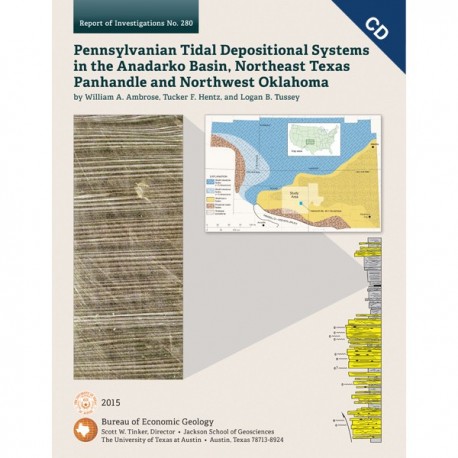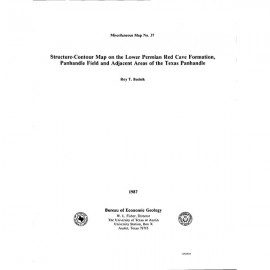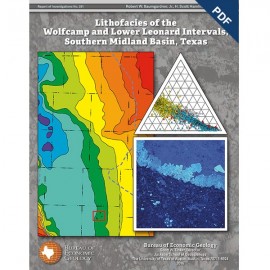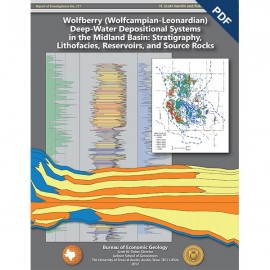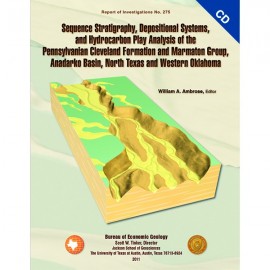Reports of Investigations
-
Books & Reports
- Reports of Investigations
- Guidebooks
- Udden Series
- Geological Circulars
- Down To Earth
- Atlases of Major Oil and Gas Reservoirs
- Texas Memorial Museum Publications
- Environmental Geologic Atlas of the Texas Coastal Zone
- Mineral Resource Circulars
- Other Reports
- Seminars and Workshops
- Handbooks
- Submerged Lands of Texas
- Symposia
- Annual Reports
- Open File Reports
-
Maps & Cross Sections
- Thematic Maps
- Miscellaneous Maps, Charts & Sections
- Geologic Atlas of Texas
- STATEMAP Project Maps
- Geologic Quadrangle Maps
- Cross Sections
- Highway Geology Map
- Energy and Mineral Resource Maps
- Shoreline Change and Other Posters
- Wilcox Group, East Texas, Geological / Hydrological Folios
- Bouguer Gravity Atlas of Texas
- River Basin Regional Studies
- Featured Maps
- Posters
- Teachers & the Public
-
Geological Society Publications
- Gulf Coast Association of Geological Societies
- Alabama Geological Society
- Austin Geological Society
- Corpus Christi Geological Society
- Houston Geological Society
- Lafayette Geological Society
- Mississippi Geological Society
- New Orleans Geological Society
- South Texas Geological Society
- GCS SEPM Publications
- Historic BEG & UT Series
Pennsylvanian Tidal Depositional Systems in the Anadarko Basin...Panhandle and Northwest Oklahoma. CD-ROM
RI0280CD
RI0280CD. Pennsylvanian Tidal Depositional Systems in the Anadarko Basin, Northeast Texas Panhandle and Northwest Oklahoma, by W. A. Ambrose, T. F. Hentz, and L. B. Tussey. 40 p., 12 tables, 2015. CD-ROM.
To purchase this publication in book format, please order RI0280.
To purchase this publication as a download, please order RI0280D.
ABSTRACT
A thick (>6,000-ft [>1,830-m]) succession of Desmoinesian to Virgilian (Pennsylvanian) strata in the northwest part of the Anadarko Basin contains a variety of tide-modified deposits. This succession, which encompasses the Marmaton Group (Upper Desmoinesian), Cleveland Formation (Missourian) and Douglas Group (Virgilian), records progradation of highstand tide-modified delta and littoral systems punctuated by lowstand incised-valley deposits. Tidal stratification in this succession includes asymmetric, double-draped ripples, reactivation surfaces, flaser bedding, rhythmic, laminar stratification, upper flow regime planar stratification, and minor herringbone stratification. Tidal amplification and reworking of deltaic and littoral sediments was controlled by (1) basin configuration, consisting of a broad, shallow shelf merging northward with an extensive epicontinental seaway in the U.S. Midcontinent, and (2) the formation of embayments during periods of relative sea-level fall, notably in the Cleveland Formation, in which an east-west-trending, lowstand paleovalley contains a vertical succession of coarse-grained fluvial-channel, tidal-channel, sandy tidal flat, muddy tidal flat, and transgressive-estuarine facies.
Local paleogeography was an important factor in the preservation of tidal signatures in the Marmaton to Douglas succession, where the relative weakness of wave and fluvial processes in marginal areas in depocenters resulted in preservation of rhythmic bedding and bidirectional, double-draped ripples. A macrotidal setting is inferred for parallel, narrow, and dip-elongate, upward-coarsening sandstone bodies in highstand-shelf systems in the Marmaton Group. In contrast, ~10-ft (~3-m) intertidal deposits and absence of large-scale bed forms such asestuarine-floor tidal sand bars in the Cleveland Formation and Douglas Group suggests microtidal regimes.
Gross-sandstone thickness maps of highstand and lowstand systems tracts within the Cleveland Formation and Marmaton Group document systematic changes in sandstone-body thickness, continuity, and regional extent through time. These variations in sandstone-body geometry are a function of a unique paleogeomorphologic setting within each systems tract. Abrupt changes in sandstone-body geometry between each systems tract control variations in reservoir continuity and permeability pathways that should be considered in future resource development.
Keywords: Anadarko Basin, Texas Panhandle, , Texas, tidal deposits, Pennsylvanian, Marmaton Group, Cleveland Formation, Tonkawa Sandstone
CONTENTS
Abstract
Introduction
Objectives, Database, and Methods
Objectives
Database and Methods
Geologic Setting
Tidal Recognition Criteria
Marmaton Group
Geologic Setting
Tidal Sand Ridge
Description
Interpretation
Cleveland Formation
Geologic Setting
Tidal Channel
Description
Interpretation
Tidal Flat
Description
Interpretation
UFR (Upper Flow Regime) Sand Flat
Description
Interpretation
Douglas Group
Geologic Setting
Subtidal Facies
DescriptionW
Interpretation
Tidal Flat and Tidal Rhythmites
Description
Interpretation
Discussion
Paleotidal Range in the Marmaton to Douglas Succession
Basin Configuration
Sandstone-Body Geometry and Stratification
Marmaton Group
Cleveland Formation
Thickness of Intertidal Successions
Sequence-Stratigraphic and Facies Controls on Sandstone-Body Continuity and
Reservoir Quality in the Marmaton Group and Cleveland Formation
Highstand Systems Tract
Lowstand Systems Tract
Transgressive Systems Tract
Conclusions
Acknowledgments
References
Figures
1. Pennsylvanian stratigraphic section in the northwest part of the Anadarko Basin
2. Location of study area and cored wells in this study and representative stratigraphic column of the Marmaton Group and Cleveland Formation
3. Thickness of preserved Pennsylvanian strata in the Rocky Mountains and southwestern U.S.
4. Gross-sandstone thickness maps of the Marmaton Group and Cleveland Formation in the northwest part of the Anadarko Basin
5. Geological attributes of the Devon No. 44 IH Penelope Moore well, Hemphill County, Texas
6. Geological attributes of the Internorth No. 46-1 Humphreys well in Hemphill County, Texas
7. Tide-modified, highstand littoral deposits in the Douglas Group in the Internorth No. 46-1 Humphreys well
8. Geological attributes of the Cleveland Formation in the Sun No.1 Bradford well, Lipscomb County, Texas
9. Geological attributes of the Maxus No. 371-D Tubb well, Lipscomb County, Texas
10. Geological attributes of the Marmaton Group in the Sun No. 1 Blau well, Lipscomb County, Texas
11. Paleogeography of the lower Virgilian Tonkawa Sandstone in the Douglas Group in the U.S. Midcontinent
12. Average thickness of sandstone laminae and cycles in rhythmically bedded, highstand drowned-marsh facies in the Douglas Group in the Internorth No. 46-1 Humphreys well at 6,995.5 ft (2,132.8 m)
Citation
Ambrose, W. A., Hentz, T. F., and Tussey, L. B., 2015, Pennsylvanian Tidal Depositional Systems in the Anadarko Basin, Northeast Texas Panhandle and Northwest Oklahoma: The University of Texas at Austin, Bureau of Economic Geology, Report of Investigations No. 280, 40 p.
